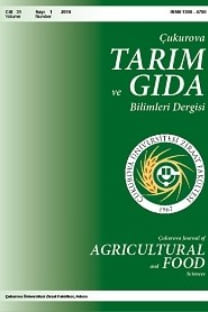Nohutlarda Ascochyta rabiei’nin Bazı Ticari Fungisitlere Dayanıklılık Durumunun Belirlenmesi
Ascochyta rabiei, Fungisitlere dayanıklılık, Nohut
Ascochyta rabiei, Fungisitlere dayanıklılık,
___
- Ahmed, H. U., Chang, K. F., Hwang, S. F., Gossen, B. D., Howard, R. J. and Warkentin, T. D. (2006) Components of disease resistance in desi and kabuli chickpea varieties against ascochyta blight. Plant Pathol. J. 5: 336–342.
- Akem, C., S. Kabbabeh, and Ahmed S. (2004) Integrating cultivar resistance with a single fungicide spray to manage ascochyta blight for increased chickpea yields. Plant Pathol. J. 3:105–110.
- Anonim. (2011).Tarım ve Orman Bakanlığı, Tarımsal Araştırmalar ve Politikalar Genel Müdürlüğü Bitki Sağlığı Araştırmaları Daire Başkanlığı, Mercimek Entegre Mücadele Teknik Talimatı. Ankara.
- Arıcı, Ş. E., Evsen, M.A (2018) Nohut Antraknozu (Ascochyta rabiei)’nun Entegre Hastalık Yönetimi. Erzincan Üniversitesi, Fen Bilimleri Enstitüsü Dergisi, 2018, 11(3), 488-498.
- Aveskamp, M. M. Gruyter J de, Woudenberg JHC, Verkley GJM, Crous PW. (2010) Highlights of the Didymellaceae: A polyphasic approach to characterise Phoma and related pleosporalean genera. Studies in Mycology, 65, 1-60.
- Chongo, G. and Gossen, B. D. (2003) Diseases of chickpea. Pages 185–190 in K. L. Bailey, B. D. Gossen, R. Gugel, and R. A. A. Morrall, eds. Diseases of field crops in Canada. Canadian Phytopathological Society, Saskatoon, SK. 290 pp.
- Demirci, F., H. Bayraktar, I. Babaliogullu, F.S. Dolar, and S. Maden. (2003) In vitro and in vivo effects of some fungicides against the chickpea blight pathogen, Ascochyta rabiei. J. Phytopathol. 151:519-524.
- Dey, S.K. and G. Singh. (1994) Seedborne infection of Ascochyta rabiei in chickpea and its transmission to aerial plant parts. Phytoparasitica 22:31–37.
- Endes, A (2021) Influence of culture media, temperature, pH and light regime on mycelial growth of Ascochyta rabiei. Int J Agric For Life Sci 5(1): 87-93.
- FAO 2020. Food And Agriculture Organization Of The United Nations Rome. 2018. (Erişim tarihi: 10.11.2022). Gan, Y. T., Siddique, K. H. M., Macleod, W. J. and Javakumar, P. (2006) Management options for minimizing the damage by ascochyta blight (Ascochyta rabiei) in chickpea (Cicer arietinum L.). Field Crop Res. 97: 121 – 143.
- Gaur, R. B., Singh, R. D. (1985) Control of Ascochyta blight of chickpea through foliar spray. ICPN 13, 22--24. in Syria ve Lebanon. Phytopath. Medit. 24:265-266.
- Kader, D. A. A., El-Vakil, A., Tohami, M. R., Ghoniem, M. I. (1990) Effect of some agricultural practices and chemical control on the incidence of Ascochyta blight of chickpea. Egyptian J. Phytopathol. 21, 31-43.
- Kaiser, W., J. (1973) Factors affecting growth sporulation, pathogenicity and survival of Ascochyta rabiei. Mycologia, 65: 444-457.
- ISSN: 2636-7874
- Başlangıç: 1973
- Yayıncı: Çukurova Üniversitesi
Kabin Tipi Kurutucularda Güneş Enerjisi ile Kayısı Kurutulması
Harun Kemal ÖZTÜRK, Hande MUTLU ÖZTÜRK
Tohuma Uygulanan Bakteriyel Antagonistlerin Biberde Bakteriyel Leke Hastalığına Etkisi
İrem Buse TÜMEN, Benian PINAR AKTEPE, Yesim AYSAN
Omar ALSENJAR, Hakan AKSU, Mahmut ÇETİN
Nohutlarda Ascochyta rabiei’nin Bazı Ticari Fungisitlere Dayanıklılık Durumunun Belirlenmesi
Çukurova Bölgesinde Muz Tarımı Yapılacak Kimi Alanların Muza Uygunluk Düzeyinin Değerlendirilmesi
Yakup Kenan KOCA, Yavuz Şahin TURGUT, Gülden KOCA
Aşağı Seyhan Ovasında Açık ve Kapalı Sulama Sistemlerinin Üreticiler Tarafından Değerlendirilmesi
Samed SALABGİR, Dilek Bostan BUDAK
Handan VURUŞ AKÇAÖZ, Ayşenur GÜZEL, Büşra METİN, Valjon REDZEPİ
Çukurova Üniversitesi Uzun Süreli (Çakıllı) Tarla Denemeleri ve Araştırma Çıktıları
